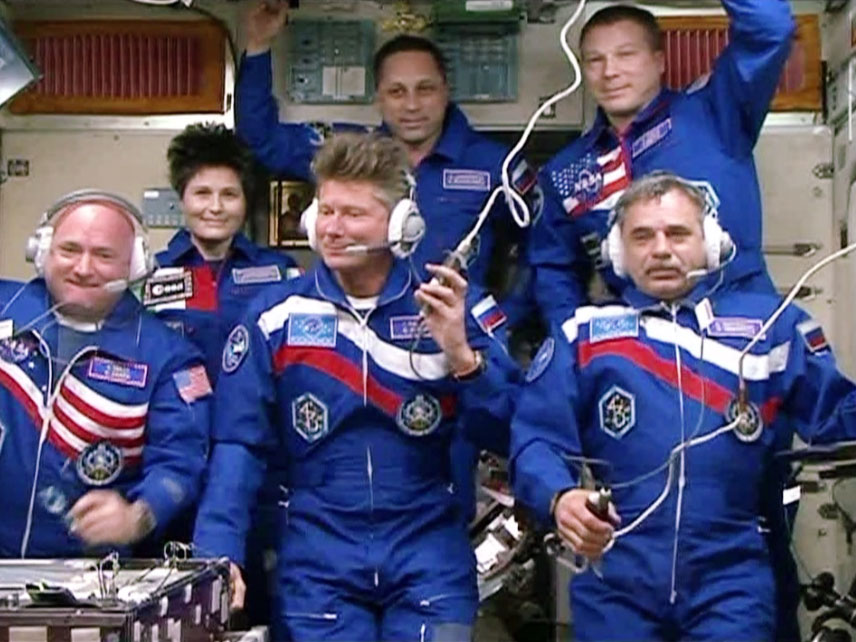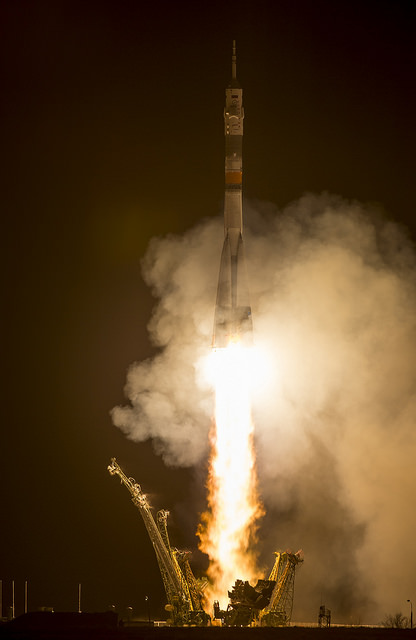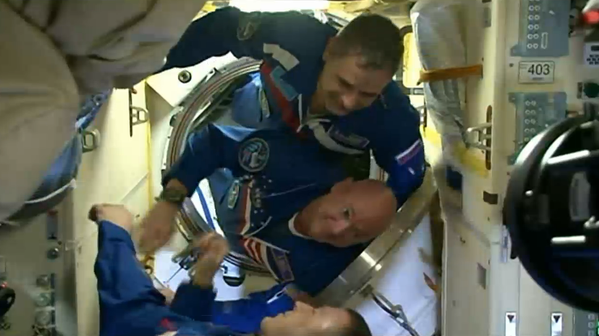
SPACE STATION WEEKLY UPDATE March 23 – March 29, 2015 — The International Space Station (ISS) Expedition 43 crew members kept busy last week, continuing work for the station’s ongoing research and science experiments while also preparing for upcoming cargo delivery. They also welcomed three new crew members, including two who will remain in space for nearly a year (342 days), bringing the number of humans living in space back up to six.
NASA astronaut Terry Virts performed work on current investigations in the Light Microscopy Module (LMM)—a facility on the ISS that houses the most recently updated diagnostic hardware and software for researchers to use for experiments. He removed the Advanced Plant Experiments 3 (APEX-03-1) and put in a sample for the Advanced Colloids Experiment-Microscopy-3 (ACE-M-3) for the team of scientists on the ground to begin a 72-hour stretch of observations and imaging.

APEX-03-1 is an ongoing study in the Veggie facility used to determine how the roots and cells of plant seedlings from the model plant Arabidopsis thaliana (thale cress) grow in microgravity. The inexpensive Veggie facility was built with a flat-panel light bank to help plants grow and for ease of observation by the astronauts. Once a small amount of time has passed for growth, the plants will be photographed, harvested, and preserved by the crew members so that scientists on Earth can conduct more in-depth studies.
Scientists hope to learn more about the molecular pathways that determine how roots grow and cell walls develop. On Earth this may be of use to the agriculture industry, as more efficient practices might be developed for the creation of crops that use important resource, like water.
According to NASA, the ACE-M-3 research will allow scientists to learn more about the relationship between the shape, crystal symmetry, and structure of complex, three-dimensional structures from small particles suspended inside a fluid medium after studying their design and assembly. These 3-D structures play a pivotal role in creating better optical materials for use in the computer industry, which could increase global profits by billions of dollars per year.
Astronauts on board the space station are also involved in ongoing studies for the Circadian Rhythms investigation. European Space Agency (ESA) astronaut Samantha Cristoforetti finished her fifth session last week. Astronauts on the ISS see over a dozen sunrises per day, and scientists believe that the absence of a 24-hour light and dark cycle changes the astronaut’s circadian clocks, which play the role of telling human bodies to sleep or wake up. The investigation will observe synchronized circadian rhythms and the way they change during long periods of time in space, as well as how reduced physical activity, microgravity, and an artificially controlled environment alter them. When an astronaut’s body composition and body temperature changes in microgravity, a shift in their circadian rhythms may also occur.
Gaining more insight into the bizarre concept of circadian rhythms will provide crucial information that will benefit future crew members’ performance and health. It will also be useful in providing a comparison for the results from studies of sleep disorders, autonomic nervous system disorders, and shift work-related disorders on Earth.
Earlier in the week, the three crew members on board the station worked on medical studies. Virts and Cristoforetti completed 120-day medical tests. Virts took a vision test and made measurements to contribute to the Prospective Observational Study of Ocular Health in ISS Crews (Ocular Health) investigation. The study uses ocular coherence tomography to create a comprehensive 3-D image of the retina and interior of the eyes.

The effects of spaceflight impair some astronaut’s vision. Ocular Health studies will compare data collected on the astronauts’ visual health during long-term spaceflights and once they are back on Earth. In addition to observing visual impairment, changes will also be measured that are thought to manifest from intracranial pressure due to the effects of microgravity on the visual, vascular, and central nervous systems. The length of time it takes for visual health to be restored in the crew members once they are back on the ground will also be recorded for use in the study.
The crew members also spent time last week preparing for an upcoming launch of another SpaceX Dragon cargo capsule on a Falcon-9 rocket, which will deliver several tons of critical supplies and new science investigations and technology research to the ISS as soon as April 10. Virts and Cristoforetti spent time packing NanoRacks Cubesat deployers as well—formerly used in Japan’s Kibo lab module—to be loaded onto Dragon and returned to Earth at the conclusion of what will be SpaceX’s sixth commercial resupply mission under NASA contract (CRS-6).
Three new crew members joined Expedition 43 when their Soyuz TMA-16M spacecraft docked with the space station at 9:33 p.m. EDT on Friday, March 27, 2015. NASA astronaut Scott Kelly, along with cosmonaut Mikhail Kornienko, will remain on board for close to a year (342 days), while cosmonaut Gennady Padalka will stay for about six months and take over command at the start of Expedition 44 in May. The crew members will work on several hundred experiments covering the subjects of biology, biotechnology, physical science, and Earth science.
Data from the one-year mission will help scientists gain further insight into the way the human body reacts and adapts to the rough environmental effects of space. It will be used to learn if there are ways to minimize the risks to astronauts on long-duration missions to asteroids and Mars in the future, which are both destinations NASA intends to send crews to starting next decade with the Space Launch System (SLS). Also, data and samples taken from Kelly and his genetically identical twin brother, former NASA astronaut Mark Kelly, will be compared in a set of studies to observe the small changes that may occur during those long-term missions.
Want to keep up-to-date with all things space? Be sure to “Like” AmericaSpace on Facebook and follow us on Twitter & Instagram: @AmericaSpace



